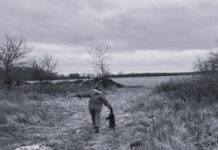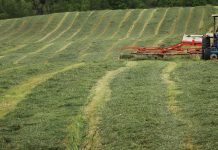It’s January and it’s cold — not surprising for our area. However, as you look out the window praying for that so-called “global warming” to kick in, you think, “This is a great time to take control of those invasive species in my woods.”
OK, so that may not be exactly what you were thinking, but this is a family publication and we have to keep it clean. In fact, this is a good time to tackle those invasive species running rampant in your woods.
Manual labor
Much of the control work is manual labor requiring thick layers of clothing to shield against the sharp thorns, so the colder weather is an ideal time to layer up for protection without getting overheated. Also, the vines and stems are easier to get at without their leaves hindering you (and walking out in the woods is a sure cure for cabin fever).
Non-native, invasive species are plants that belong somewhere far away, yet here they are invading your woods, taking up space, using resources, and crowding out the natives.
Invasive and noxious species, such as wild grapevines and multi-flora rose, are a serious threat and can grow in every type of forest stand, especially stands that have been disturbed by construction, excavation, drilling, burning, farming, grazing, or heavy logging.
They can be dealt with by a variety of techniques such pulling them out of the ground, cutting the stems or vines, and treating with a mix of chemicals. Non-native, invasive species are weeds, but they are not necessarily the only weeds growing in your woods.
What to control?
Native weeds are growing there, as well, and as a landowner, you need to decide what to control and how much to accomplish your forestry goals.
Keep in mind that native species contribute to the biological diversity and ecological quality of your woods so careful planning of their control is critical for the overall health and value of your woods.
Two of the more common invasive and noxious species in our area are wild grapevines and multiflora rose bushes. Both of these species are aggressive and damaging to your woods.
Grapevines will climb the tree and attach to the top. Once the grapevines become attached, they can pull the tops down toward the ground which can cause the tree to grow in a u-shape. This results in a loss of tree form, quality, volume, and value for seed and wood production and will eventually kill the tree.
Multiflora rose
Multiflora rose can be just as destructive. Once considered as a conservation plant for erosion control and living fences, landowners were encouraged to plant it; however as time passed and the shrub took over, smothering out native plants and trees, experts are now recommending control and in many cases complete eradication.
Any non-native, invasive species control should be consistent with forest management objectives. If the objective is to grow high quality timber, then elimination of the species is usually recommended. Many invasive species require a combination of mechanical or cutting, chemical and canopy shade to be effective.
For mechanical or cutting control, hedge clippers or pruners can be used to cut the grapevines at the base of the stem near the ground. This is easier to do in winter, since the vines are free of leaves and you can easily see and reach each vine.
Make sure that every vine is severed; no matter how small it is or it will sprout again in the spring. Severe cases and large stems may require the use of a chainsaw or a professional trained in grapevine control.
Safety precautions
Personal protection such as leather gloves, safety goggles, and a hard hat are also recommended. Also an herbicide can be applied to keep the cut vine from re-rooting or growing; however check the label as some herbicides are not appropriate for a winter application.
Without the grapevines smothering the tree, its leaf growth will increase and as the tree canopy thickens, it will shade the ground below slowing the grapevine growth even more.
The cutting method for multiflora rose bushes is a little different than the method for grapevines. Multiflora rose bushes grow from the root, which requires digging up the entire root system from the ground.
Using a tractor, fasten a log chain as tightly as possible around the base of the bush. As you pull the bush from the ground with the tractor, watch to see that all roots are intact. You may need to dig up any roots that remain with a shovel to ensure that all of its roots are pulled out.
If the bush comes back in the spring, you can mow it down several times, which will eventually kill the bush or use an herbicide specifically for multiflora rose bushes.
Controlling wild grapevines and multiflora rose can be an important part of managing your woods but constant vigilance is essential.
Eradicating these invasive and noxious species on site is an attainable goal, especially if they are detected early. Although both of these species have benefits for wildlife, they can be hard on trees and need to be controlled for you to get the most out of your timber.
Forestry experts
Landowners can control these invasive and noxious species with a little instruction; however if you need or want more assistance contact your service forester or a private consultant. USDA-NRCS and ODNR’s Division of Forestry have established a partnership to provide technical assistance to forest owners and many Soil and Water Conservation Districts also have forestry experts on staff to assist landowners in this process.
Programs are available to larger woodlot owners to cost share the removal of invasive species from woodlands. The Environmental Quality Incentive Program (EQIP) is a way for landowners to receive payments and technical advice from professional foresters.
However; there are eligibility criteria that must be met such as minimum acreage and having a management plan for timber stand improvement. For more information contact your local NRCS or SWCD office.
So instead of looking out your window, praying for warmer weather, get your coat and go for a walk your woods.
If you are feeling especially adventurous, grab those pruners on your way out and get to work on those vines. You’ll be that much further ahead come springtime. Who needs global warming when you have grapevines and multiflora rose bush control to keep you warm?












